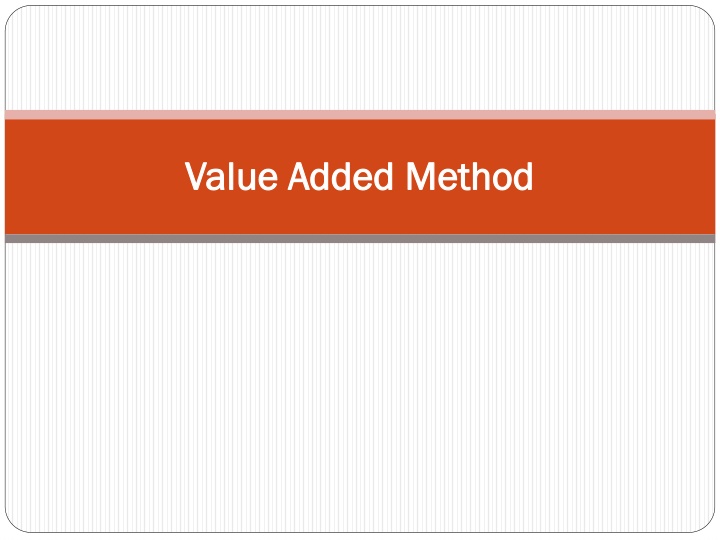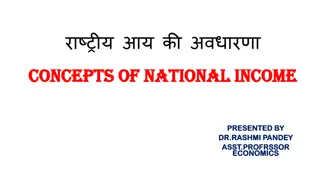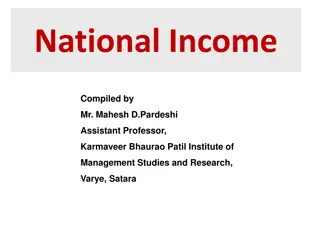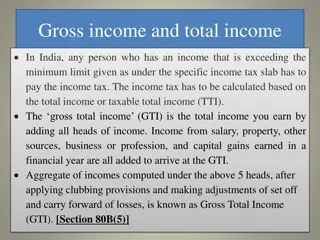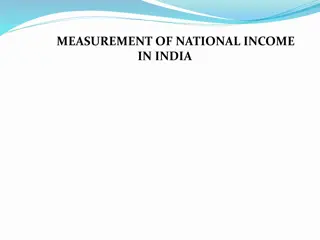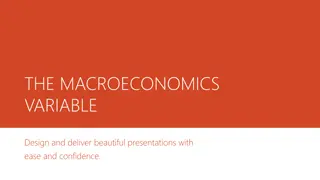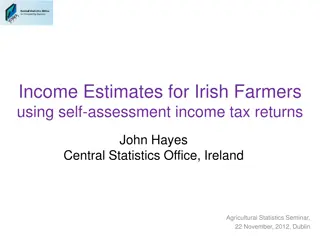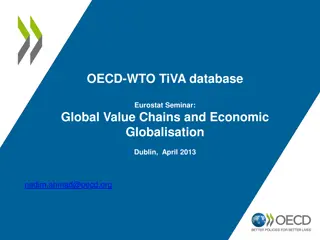Value Added Method in National Income Calculation
The Value Added Method is a key approach in calculating national income, focusing on the value addition at various production stages. It helps avoid double counting errors by determining the value added by each organization to the final product. Learn how this method plays a vital role in estimating national income accurately.
Download Presentation

Please find below an Image/Link to download the presentation.
The content on the website is provided AS IS for your information and personal use only. It may not be sold, licensed, or shared on other websites without obtaining consent from the author.If you encounter any issues during the download, it is possible that the publisher has removed the file from their server.
You are allowed to download the files provided on this website for personal or commercial use, subject to the condition that they are used lawfully. All files are the property of their respective owners.
The content on the website is provided AS IS for your information and personal use only. It may not be sold, licensed, or shared on other websites without obtaining consent from the author.
E N D
Presentation Transcript
Value Added Method Value Added Method
The most commonly used methods for calculating national income are the Income Method and Value Added Method. The value-added method is used to calculate national income at different stages of the production process in a circular flow. It represents the value-added for each unit produced in the production process. Every organization adds value to the product, which it buys from other firms as an intermediate good. The sum total of value added by every organization is the value of national income. Method, Expenditure
What is Value Added? What is Value Added? Value-added refers to the addition in the value of a raw material or intermediate good by an organization during the production process. To calculate the national income through the value-added method, the difference between the value of output and the value of intermediate goods is taken. The value-added method is the most commonly used method to estimate national income as it avoids double counting, which is a major error while calculating national income. Value Added = Value of Output Intermediate Consumption
Calculation of the Components of Calculation of the Components of Value Added Value Added 1.Intermediate Consumption The use of intermediate goods during the production process to create the final product Consumption, and the expenses occurred on intermediate goods are known as Intermediate Consumption Expenditure. In the above example,Flour is represented as an intermediate good, as it is used as a raw material for the production of the bread. However, any kind of machinery purchased for baking bread will not be considered an intermediate consumption, as its value will not be merged with the value of final goods. is termed Intermediate
2.Value of Output The market value of all goods and services produced within a country during a period of one year is known as the Value of Output. Different ways of calculating the value of output are as follows: When the whole output is sold in a financial year, then the value of output will be equal to the total sales of the output. Value of Output = Sales
When the whole output is not sold in a financial year, then the value of output will be equal to the sum of sold output and the unsold stock of output. Here, the unsold stock is the difference between closing stock and opening stock and is also known as Value of Output = Sales + Change in Stock Change in Stock = Closing Stock Opening Stock When the value of output sold is not given directly, then the value of output will be calculated by first determining the sales value. Value of Output = (Quantity Price) + Change in Stock Change in Stock.
Precautions of Value Added Method Precautions of Value Added Method 1. Intermediate goods should not be added to National Income: As the value of intermediate goods is already added to the value of final products, they should not be added to national income. The inclusion of the value of intermediate goods again to national income will result in double counting. 2. Transactions (sale and purchase) of second-hand goods must not be included: The value of second-hand goods should not be included in national income, as these goods are already counted in the year they were produced.Adding the value of these goods again will disrupt the current flow of goods and services. However, any kind of brokerage fee or commission paid on any transaction of such products should be included in the calculation of national income,as it is a productive service.
3. Self-consumption production should not be included: It is difficult to find out the market value of domestic services like housewives, etc. Therefore, the production of domestic services is not included in the calculation of national income. These types of services are produced and used within a household and do not enter the marketplace; therefore, are transactions. However, paid services like maids, drivers, etc. should be mentioned clearly in the national income, as their market value can be easily determined. 4. Self-consumption goods should be included: The production of self-consumption goods contributes to the output of a financial year; therefore, these are added to the national income of an economy. However, these products are never sold in the open market;hence,their value is estimated. Services or Domestic Services considered non-market
5. Estimated value of houses owned by people should be included: People living in their own houses do not pay rent, but enjoy the same housing services as received by people living in houses on rent. Therefore, the value of the houses owned by people is included in the national income. For this, the value is determined on the basis of an estimation of the rent of a similar house or accommodation in the market.This estimated rent is also known as imputed rent. 6. Change in the stock or inventory must be included: The change in the value of opening and closing stock or inventory of an economy is also included in the calculation of national income. In other words, the net increase in the inventory of an economy is included as a part of capital formation in the National Income.
